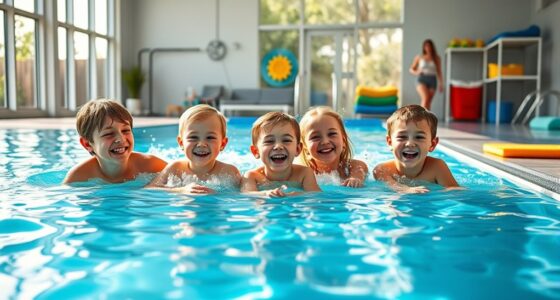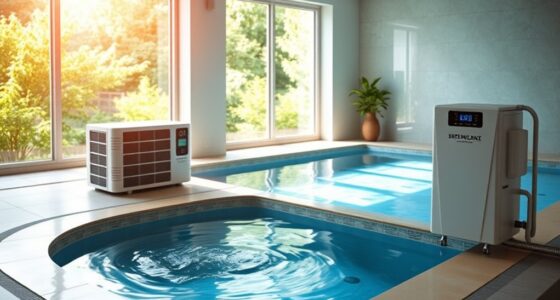To make your Endless Pool more energy-efficient, choose energy-efficient pumps, such as variable-speed models, and keep up with regular maintenance. Set your pool temperature wisely, use smart controls, and consider insulating with covers to reduce heat loss. Installing solar heaters and combining heating methods can lower energy costs. Maintaining water chemistry and scheduling upkeep also help prevent waste. Keep exploring these tips to discover how you can save more on operating expenses.
Key Takeaways
- Choose energy-efficient pumps, heaters, and filtration systems, and perform regular maintenance to optimize performance and reduce costs.
- Set the pool temperature between 78°F and 82°F using precise thermostats and time-based heating to conserve energy.
- Insulate the pool, use quality covers, and consider solar heating to minimize heat loss and utilize renewable energy sources.
- Maintain proper water chemistry to improve filtration efficiency and prevent equipment strain, reducing energy consumption.
- Implement smart controls and automation for scheduling, remote management, and system optimization to enhance overall energy efficiency.
Choosing an Energy-Efficient Pump and Filtration System

When selecting a pump and filtration system, prioritizing energy efficiency can substantially reduce your operating costs. Look for models labeled as energy-efficient or ENERGY STAR certified, which use less power while maintaining performance. Variable-speed pumps are a smart choice because they run at lower speeds when full power isn’t needed, saving energy over time. Consider the size and flow rate of the pump to match your pool’s requirements; an oversized pump wastes energy. Regular maintenance, like cleaning filters and checking for leaks, keeps your system running efficiently. Investing in a high-quality, energy-efficient pump not only cuts your electricity bills but also prolongs the lifespan of your equipment, making it a cost-effective and environmentally friendly choice. Additionally, understanding the total‑cost clarity of your system can help you make more informed decisions that balance upfront costs with long-term savings.
Optimizing Pool Temperature Settings for Cost Savings
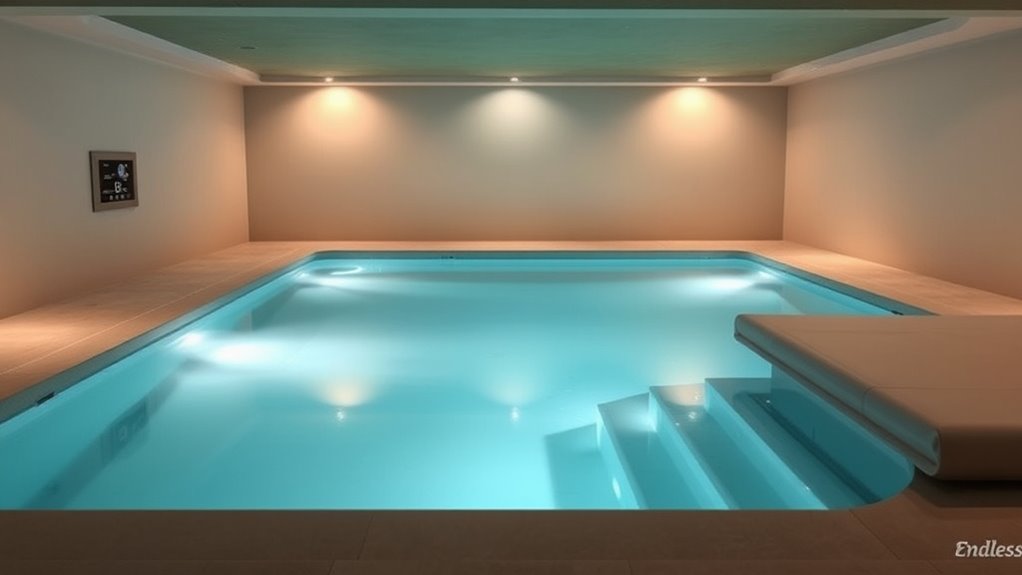
Setting your pool temperature within the ideal range can ensure energy costs are reduced substantially. Using precise thermostat controls helps maintain consistent temperatures without over-heating, saving you money. Implementing time-based heating strategies ensures your pool warms only when needed, maximizing efficiency. Additionally, utilizing advanced insulation materials around your pool equipment can prevent heat loss and further improve energy savings.
Ideal Temperature Range
Have you ever wondered how maintaining the right pool temperature can save you money? The ideal range for an energy-efficient Endless Pool is typically between 78°F and 82°F. Staying within this range balances comfort and energy use, preventing your heater from working overtime. Lower temperatures save energy but might feel too cold for some users, while higher temperatures offer more comfort but increase costs. If you use your pool frequently, aim for the lower end of the range to cut expenses. Conversely, if you only swim occasionally, a slightly warmer setting may be acceptable. Consistently maintaining your pool within this temperature window helps reduce energy consumption, extending your heater’s lifespan and lowering operating costs. Adjusting your thermostat to stay within this range is a smart, cost-effective choice. Proper gear shifting on your gravel bike can also help optimize energy efficiency and ensure smooth operation.
Precise Thermostat Control
Using a precise thermostat control system allows you to fine-tune your pool’s temperature for maximum energy savings. By adjusting the thermostat accurately, you avoid unnecessary heating and reduce energy waste. Setting your pool temperature just right not only cuts costs but also ensures comfort. Consider the table below for ideal temperature settings based on usage:
| Usage | Recommended Temp | Energy Impact |
|---|---|---|
| Regular swimming | 78-80°F | Moderate energy use |
| Occasional use | 75-78°F | Lower energy costs |
| Therapeutic purposes | 85°F | Higher energy consumption |
| Maintenance/cleaning | 70-75°F | Minimal energy use |
Proper control helps you maintain efficiency without sacrificing comfort, saving money on energy bills. To further enhance efficiency, monitoring energy consumption can help identify opportunities to optimize your pool’s operation and reduce costs.
Time-Based Heating Strategies
Implementing time-based heating strategies can considerably reduce your energy costs by ensuring your pool only heats when necessary. By scheduling your heater to turn on just before you plan to use the pool, you avoid wasting energy keeping it warm when it’s unused. For example, set your heater to activate an hour before your typical swim time and turn off afterward. If your pool isn’t used daily, reduce heating frequency or lower the temperature during off-peak times. Using a timer or smart control system makes this easy. Consistent scheduling helps maintain comfort while preventing unnecessary energy consumption. Understanding the refrigeration cycle and how heat pumps operate can further optimize your system’s performance and efficiency. Over time, these small adjustments can lead to significant savings and a more efficient, cost-effective operation of your Endless Pool.
Implementing Smart Pool Controls and Automation

Adopting smart pool controls and automation can considerably reduce energy consumption and operating costs. By integrating these systems, you gain precise control over your pool’s temperature, filtration, and lighting, maximizing energy use. You can set schedules that match your routine, avoiding unnecessary operation during inactive hours. Additionally, automation systems can monitor pool conditions in real time, adjusting settings automatically for efficiency. Incorporating energy-efficient features can further enhance your pool’s performance and reduce costs over time. Consider these key features:
- Programmable timers to align heating and filtering with your schedule.
- Remote control access via smartphone or tablet for convenience and quick adjustments.
- Sensors that detect water temperature and quality, enabling automated responses to maintain ideal conditions.
Implementing these controls ensures your pool operates efficiently, saving money while maintaining comfort.
Insulating Your Endless Pool to Minimize Heat Loss

After setting up smart controls to optimize your pool’s operation, addressing heat loss becomes the next step in maximizing efficiency. Insulating your Endless Pool keeps the warmth in and reduces the workload on your heating system. Start by applying insulating panels or foam boards around the pool’s sides and underneath if possible. Use a high-quality cover to trap heat when the pool isn’t in use. Seal any gaps or leaks around fittings and edges to prevent drafts. Consider insulating the pool’s plumbing lines to minimize heat loss through the pipes. Proper insulation not only maintains consistent water temperature but also cuts down on energy costs. Additionally, using energy-efficient equipment can further reduce your pool’s operational expenses. Proper insulation not only maintains consistent water temperature but also cuts down on energy costs. By keeping heat in, you’ll enjoy a warmer pool with less energy expenditure, saving you money over time.
Utilizing Solar Heating Options for Sustainable Warmth
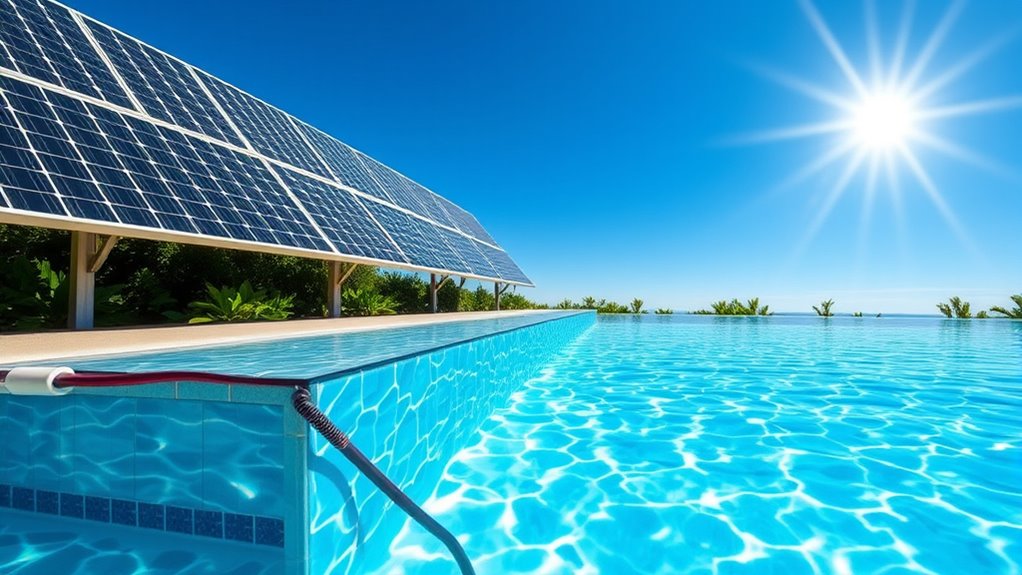
Harnessing the power of the sun is a smart way to heat your Endless Pool sustainably and reduce energy costs. Solar heating systems capture sunlight and convert it into warmth, lowering your reliance on conventional energy sources. To maximize efficiency, consider these options:
Using solar energy to sustainably heat your Endless Pool reduces costs and reliance on traditional power sources.
- Solar Collectors: Install panels on your roof or a nearby structure to absorb sunlight directly.
- Flow Rate Optimization: Adjust your system’s flow rate to enhance heat transfer without overworking the pumps.
- Backup Heating Integration: Combine solar with an electric or gas heater to guarantee consistent warmth on cloudy days or during peak use times.
- Energy Efficiency is vital for prolonging system lifespan and minimizing costs over time.
Maintaining Water Chemistry to Enhance Energy Efficiency
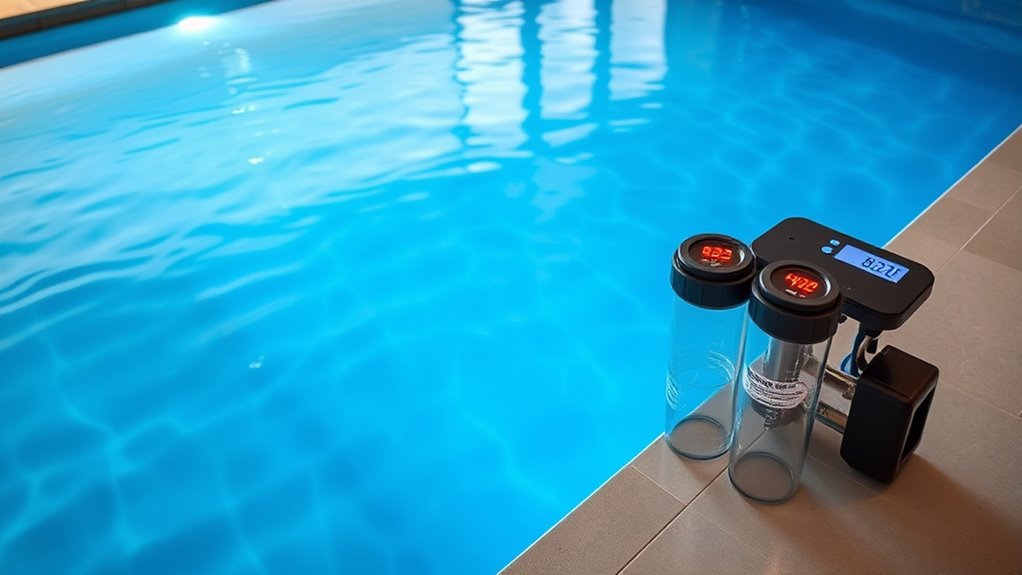
Maintaining proper water chemistry is essential for maximizing your pool’s energy efficiency. When your water’s pH, alkalinity, and sanitizer levels are balanced, your filtration system works more effectively, reducing energy waste. Imbalanced water can cause scale buildup or corrosion, forcing your pump and heater to work harder, which increases energy consumption. Regularly test your water using test strips or a kit, and adjust chemicals as needed to keep levels within recommended ranges. Proper chemical balance also prevents algae growth and cloudiness, reducing the strain on your filtration system. By maintaining ideal water chemistry, you ensure your pool runs smoothly, consumes less energy, and requires fewer repairs, saving you money and extending the lifespan of your equipment.
Scheduling Regular Maintenance to Prevent Energy Waste
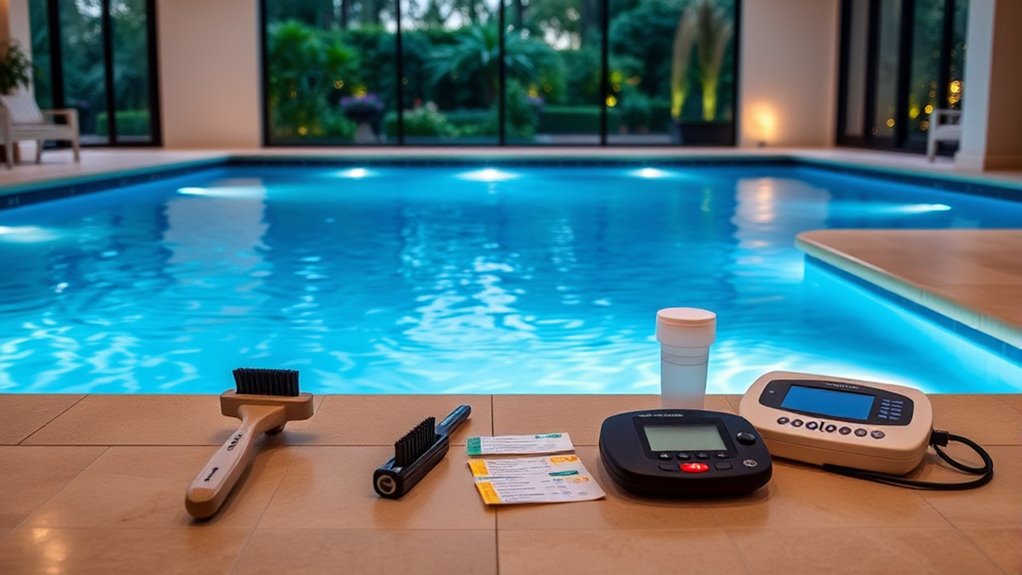
Scheduling regular maintenance is essential for preventing energy waste and keeping your pool running efficiently. When you stay on top of maintenance tasks, you ensure that your equipment operates at its best and avoid costly repairs. Proper upkeep minimizes energy-consuming issues like clogged filters or worn-out pumps that force your system to work harder. Additionally, maintaining a healthy pool environment can prevent issues related to canine affection and love, which emphasizes the importance of consistent care.
To maximize efficiency, focus on these key areas:
- Clean and inspect filters regularly to maintain proper flow and reduce strain on the pump.
- Check for leaks or damaged seals that can cause water and energy loss.
- Test and calibrate your pool’s equipment to ensure it runs at peak performance.
Consistent maintenance keeps your pool energy-efficient and extends its lifespan.
Incorporating Cover Solutions to Reduce Evaporation and Heat Loss
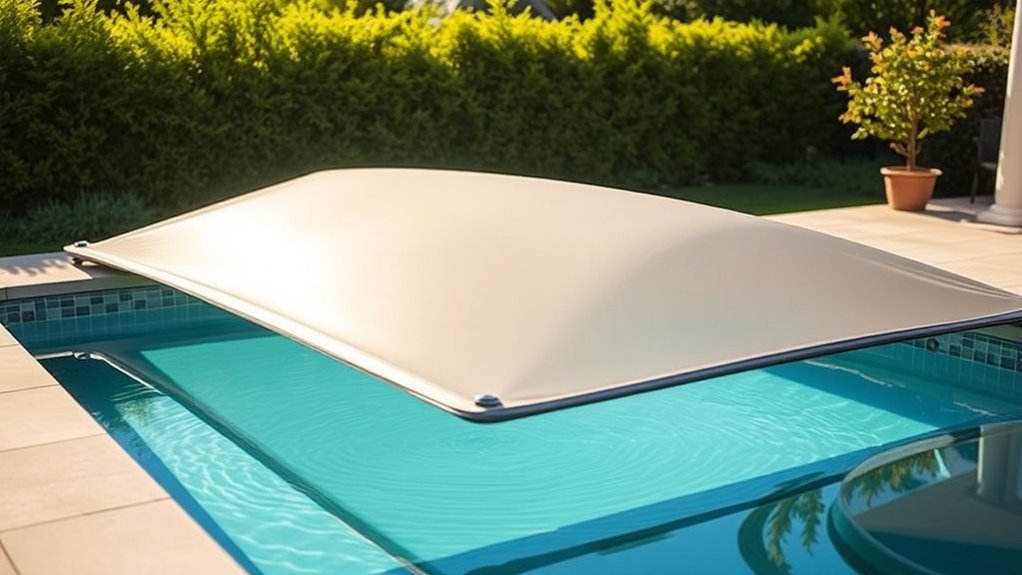
Using the right cover materials can considerably cut down evaporation and heat loss in your system. Different types of covers offer varying levels of evaporation reduction and heat retention, so choosing the appropriate one makes a big difference. Implementing effective cover solutions helps you save energy and lower operating costs. In regions known for their diverse culinary options, outdoor seating with proper covers can enhance guest experiences while conserving energy.
Cover Materials & Types
Have you considered how the right cover materials can markedly cut down on evaporation and heat loss in your system? The material you choose directly impacts insulation efficiency and durability. For ideal performance, look for covers made from high-quality foam or insulated vinyl, which provide better thermal resistance. Additionally, consider the following:
- Thickness: Thicker covers offer superior insulation but may be harder to handle.
- Material properties: UV-resistant and weatherproof materials extend lifespan and maintain insulating qualities.
- Fit and seal: A snug, secure fit minimizes gaps that can cause heat escape or evaporation.
Selecting the right cover material ensures your pool retains heat more effectively, reducing energy costs and increasing comfort. Properly chosen covers are a smart investment in your pool’s efficiency and longevity.
Evaporation Rate Reduction
Choosing the right cover material not only enhances insulation but also plays a vital role in reducing evaporation from your pool. Evaporation can account for considerable heat loss, increasing your energy costs. Using a high-quality, tightly fitting cover minimizes water vapor escape, keeping warm air in and cold air out. Some covers feature a vapor barrier layer that further blocks moisture transfer. To maximize evaporation reduction, guarantee the cover fits snugly without gaps, and consider using a cover with a reflective surface to bounce heat back into the water. Regularly removing debris and maintaining a clean cover also helps maintain its effectiveness. By implementing these cover solutions, you’ll appreciably cut down on water and heat loss, reducing energy consumption and operating costs.
Heat Retention Benefits
Since evaporation and heat loss can substantially lower water temperature, implementing effective cover solutions helps retain warmth and improve energy efficiency. A good cover minimizes heat escape, reducing the energy needed to maintain your desired temperature. To maximize heat retention, consider these options:
- Use insulated covers that trap heat and prevent cold air from entering.
- Opt for a tight-fitting cover to reduce gaps where heat can escape.
- Consider automatic covers that can be easily closed after use, maintaining consistent warmth.
Comparing Energy Costs of Different Pool Equipment and Technologies
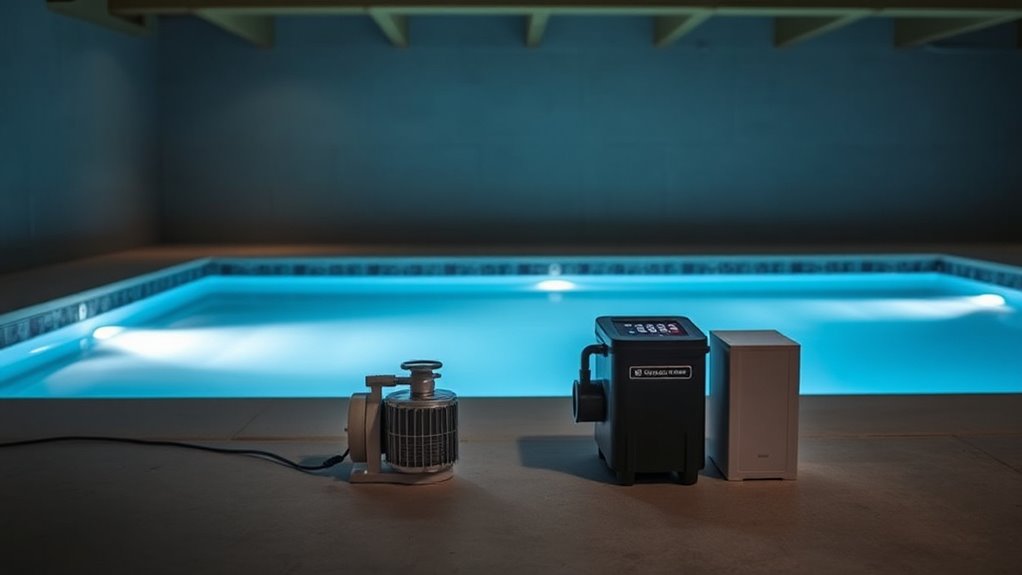
When evaluating the energy costs of various pool equipment and technologies, it’s important to contemplate how each option consumes power during operation. Pumps, heaters, and automation systems differ markedly in efficiency. For example, variable-speed pumps use less energy than single-speed models, saving you money over time. Heat pumps are generally more energy-efficient than electric or gas heaters, especially in moderate climates. To compare, consider this table:
| Equipment Type | Energy Efficiency |
|---|---|
| Single-Speed Pump | Higher energy consumption |
| Variable-Speed Pump | Lower energy consumption |
| Electric Heater | Moderate efficiency, higher costs |
Choosing the right equipment can drastically reduce ongoing energy expenses and improve your pool’s overall efficiency.
Frequently Asked Questions
How Does the Size of My Endless Pool Affect Energy Consumption?
The size of your endless pool directly impacts your energy consumption because larger pools require more water to heat, circulate, and maintain temperature. If your pool is bigger, your heater and pump work harder and longer, increasing energy use. To save energy, consider choosing a size that fits your needs, and keep the pool well-insulated and properly maintained. Smaller pools generally consume less energy and are easier to keep efficient.
Can Natural Landscaping Reduce Heating and Cooling Costs?
Imagine your backyard transforming into a lush, natural fortress that shields your pool from the elements. Yes, natural landscaping can drastically cut your heating and cooling costs by acting as a living barrier—blocking wind, providing shade, and trapping warm air during winter. This green fortress not only beautifies your space but acts like a giant, eco-friendly thermostat, helping you save energy and money effortlessly.
What Are the Long-Term Savings of Installing Renewable Energy Systems?
Installing renewable energy systems can save you a significant amount on your long-term energy bills. By harnessing solar, wind, or geothermal power, you reduce reliance on fossil fuels and lower your monthly expenses. Over time, these systems often pay for themselves through energy savings, tax incentives, and rebates. Plus, you’ll contribute to a healthier environment, gaining peace of mind knowing you’re making a sustainable choice that benefits both your wallet and the planet.
How Do Seasonal Climate Changes Impact Energy Efficiency Strategies?
Seasonal climate changes directly affect your energy efficiency strategies. During colder months, you’ll need better insulation and possibly a cover to retain heat, reducing heating costs. In warmer seasons, you might focus on cooling systems or shading to prevent heat gain. Adjust your pool’s temperature settings accordingly, and use energy-efficient equipment to adapt to these fluctuations, ensuring consistent performance while saving on energy costs year-round.
Are There Government Incentives for Upgrading to Energy-Efficient Pool Equipment?
Yes, there are government incentives available for upgrading to energy-efficient pool equipment. You can often find rebates, tax credits, or grants designed to encourage energy conservation. Check with local, state, or federal programs to see what’s available in your area. By taking advantage of these incentives, you can lower your upgrade costs and enjoy more energy-efficient operation of your pool, saving you money in the long run.
Conclusion
By choosing energy-efficient equipment, optimizing settings, and maintaining your pool well, you can considerably cut costs and reduce your environmental impact. Have you considered how small changes, like insulating or covering your pool, could lead to big savings? Taking proactive steps ensures your endless pool stays enjoyable and affordable year-round. Why not start today and make your pool more sustainable — your wallet and the planet will thank you?



